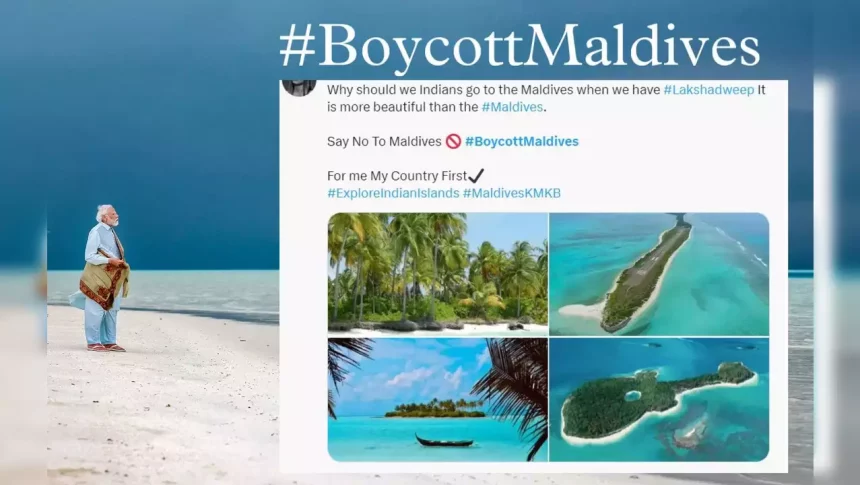In the wake of Prime Minister Modi’s serene New Year snapshots from the enchanting Lakshadweep archipelago, a subtle yet palpable wave of sentiment advocating a “Boycott Maldives” movement has emerged among Indian netizens. This trend has gained traction amid rising concerns over the Maldives’ recent political shift towards a pro-China stance, epitomized by the government’s election slogan, “India Out from Maldives.”
Boycott Maldives trends on X
The Maldives National Defence Force (MNDF) taking over hydrographic works from next June coincides with Beijing’s request to conduct deep-water exploration in the Southern Indian Ocean, fueling worries about potential Chinese surveillance activities.
What is the India-Maldives Row?
The India-Maldives row, as outlined in the article, encompasses a series of diplomatic and strategic disagreements between the two countries. Key points of contention include the Maldivian government’s decision not to renew the hydrographic survey agreement with the Indian Navy, the call for the departure of an Indian security team, and President Muizzu’s deviation from the traditional diplomatic protocol by visiting China before India. These actions, along with concerns over the slow progress of the Thilamale Bridge construction and the Maldives’ emphasis on closer ties with China, contribute to the strained relationship and the “Boycott Maldives” sentiment among Indian netizens.
President Mohamed Muizzu’s deviation from the traditional diplomatic protocol of visiting India first in favor of a visit to China underscores shifting dynamics in the Indian Ocean region. This diplomatic pivot, compounded by the President’s intent to reduce the Indian footprint in the country, challenges the longstanding “India first” policy.
President Muizzu’s voiced concerns over the slow progress of the Thilamale Bridge construction, assigned to an Indian company, have added another layer to the strained relations. Despite an agreement to establish a core group enhancing the India-Maldives partnership, recent actions by President Muizzu have sparked concerns about the Maldives’ shifting stance towards India.
In light of China’s growing influence in the region, the decision to withdraw Indian troops, choose China over India for the first official visits, and not renew the joint hydrographic agreement with India raises concerns about the priorities of the newly elected Maldivian government.
President Muizzu’s Strategic Visit to China
President Muizzu’s visit to China on January 8 is expected to yield cooperative agreements in politics, economy, culture, and political development, raising eyebrows in India. China’s extensive investments in the Maldives, totaling approximately $1.3 billion, make it the island nation’s largest external creditor.
As India observes this geopolitical realignment, the “Boycott Maldives” sentiment grows on social media. A further degree of mystery is added by the brief closure of important Maldivian official websites in the midst of this online debate, which leaves open the possibility of cyber meddling or heightened tensions.
In conclusion, the rising tide of the “Boycott Maldives” sentiment reflects not only online outrage but also underscores the evolving geopolitical dynamics in the Indian Ocean. India faces the challenge of recalibrating its approach to the Maldives amid China’s expanding influence. Emphasizing the need for nuanced diplomacy and strategic foresight in the region. Geopolitical observers remain attentive to the evolving relationship between the Maldives and major powers in the region. Recognizing the strategic importance of the Maldives and its impact on broader Indian Ocean dynamics.


